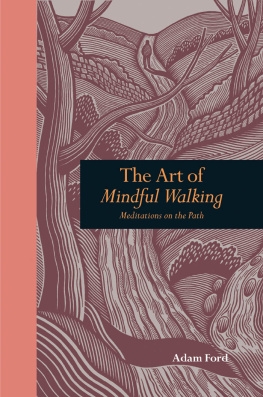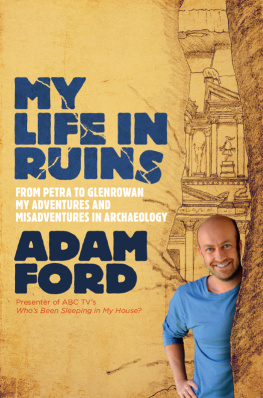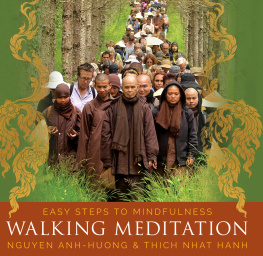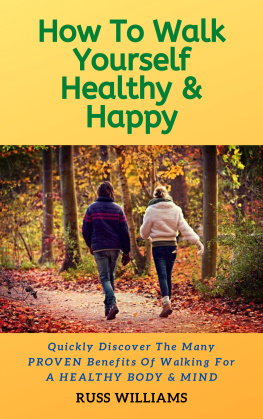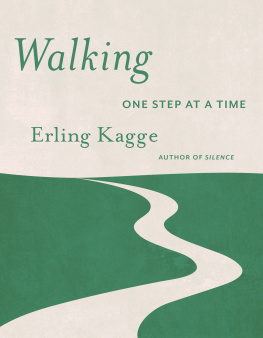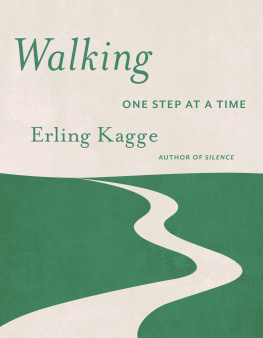
The Art of Mindful Walking
Meditations on the Path
Adam Ford
First published in the UK in 2011 by
Leaping Hare Press
210 High Street, Lewes
East Sussex BN7 2NS, UK
www.leapingharepress.co.uk
Text copyright Adam Ford 2011
Design and layout copyright Ivy Press Limited 2011
All rights reserved. No part of this book may be
reproduced or transmitted in any form or by any
means, electronic or mechanical, including
photocopying, recording or by any information
storage and retrieval system, without written
permission from the copyright holder.
British Library Cataloguing-in-Publication Data
A catalogue record for this book is available from
the British Library
Print ISBN: 978-1-907332-58-6
ePub ISBN: 978-1-908005-13-7
Mobi ISBN: 978-1-782400-63-9
This book was conceived, designed and produced by
Leaping Hare Press
Creative Director PETER BRIDGEWATER
Publisher JASON HOOK
Art Director WAYNE BLADES
Senior Editor JAYNE ANSELL
Designer RICHARD CONSTABLE
Digital Assistant EMILY OWEN
Illustrator CLIFFORD HARPER
Colour Origination by Ivy Press Reprographics

DEDICATION

For Ros
CONTENTS


INTRODUCTION
The first rule, if one has to have rules, would be: Dont set out to do some thoughtful walking. Just walk. This is the great simplicity of mindfulness as taught by the Buddha. When walking, walk; when standing, stand; when sitting, sit; when lying down, lie down. We can make life too complicated in our frantic effort to understand who we are and where we have come from.

ON BEING A HUMAN

It is not easy being a human; each of us a creature with an unbroken billion-year ancestry; unique, created by God through the miraculous process of evolution, shaped by the laws of physics, chemistry and biology, and the selective pressures of the environment; a thinking, breathing, sometimes difficult, member of the rich ecosystem of our home planet.
W E DIDNT ASK TO BE HERE and are perplexed, perhaps, about whether we have a purpose and what it might be. Our feelings and urges can make a mockery of us. We lose our poise. But Thought has emerged on Earth and leapt to a new level in us giving us a burden and a joy.
The association of thinking with walking has a long and noble history, emerging into written records with the peripatetic philosophers of ancient Greece. It is so natural to link the two that we can imagine our oldest human ancestors trudging home from the hunt, retelling the success in their minds, turning it into a story; or pondering the failure, anguishing over the loss of a favourite flint or arrowhead.
We are bodies with minds or, if you prefer, embodied minds, depending on whether you make the body the primary reality, or you feel compelled to give priority to the mind. Either way, we are forced to live with a certain tension between the two. It is in living (and walking) with this body- mind relationship that we begin to define who we are. There can be something spiritual about the simple physical activity of walking; it lies deep in the psyche of many religions. The psalmist in the Bible praises the person who walks in the way of God, and the earliest Christian community, taking up the idea, called themselves not Christians, but Followers of the Way. The oldest religion in China, Taoism, is named after the Tao, the Way, the mysterious Something that was there in the beginning before the world; it guides us back to our roots and celebrates walking in old paths. For Buddhists, the Right way of living is to follow the Eightfold Path.
What is Mindful Walking?
Mindfulness is a lovely word, one of the great contributions made by Buddhism to the world of thinking. Mindfulness does not always come naturally to humans but has to be learnt and practised. It is part of the waking up process that is the opportunity life offers to us all. The Buddha summarized his teaching in the Noble Eightfold Path eight aspects of life that need urgent attention if we are to get anywhere in our journey towards understanding and peace. Mindfulness, samma sati, is the seventh element of the path, suggesting the need for attentiveness, alertness and awareness.
Walpola Rahula, renowned Buddhist scholar-monk from Sri Lanka, defines Right Mindfulness in his What the Buddha Taught as attentiveness which is to be diligently aware, mindful and attentive with regard to (1) the activities of the body, (2) sensations or feelings, (3) the activities of the mind and (4) ideas thoughts and conceptions. This is an essential practice if one is to avoid the sluggish temptation to sleepwalk through life. Waking up becomes an adventure. And mindfulness goes well with walking.
One of my favourite images of the Buddha is of him gently touching the earth. He sits calmly in the lotus position, one relaxed hand trailing over his crossed legs, fingertips in contact with the ground. It is known as the Earth-touching mode. It refers, in the Pali tradition, to a vow he was reputed to have made in a previous life, calling the Earth as a witness, that he would one day achieve enlightenment. I see something more in it. The Buddha, while meditating, is not escaping the real world to float in some spiritual, religious realm detached from physical things. Whatever truth he finds through meditation and contemplation is rooted in the real; the spiritual and the physical are part and parcel of the same thing. The spiritual is not, as some religious types seem to imagine, a way of escape from the turmoil of the flesh.
Why Walk?
In the following chapters I shall explore the activity of walking as an exercise of body and mind, both serious and light-hearted. I will describe some walks I have done, and, by practising mindfulness, my investigation both of the reality around me and the reality within the feelings, thoughts, ideas and beliefs that make up the (sometimes clouded) landscape of my inner life. I grew up in a happy Christian household, my father a country parson. Later I found my way, through an interest in science (particularly astronomy) to being ordained an Anglican priest; was a vicar in West Yorkshire, a school chaplain in London and, for a time, a Priest-in-Ordinary at the Chapel Royal. I remain rooted in the Christian tradition, but with questions and often feeling an urge to move on. Some of my Christian beliefs have been strengthened, while others have dropped away like autumn leaves.
Walking is the simplest and most human of things. It can be a light, refreshing experience, when we open our shoulders, breathe the air, and enjoy that wonderful to be alive feeling. Or it can create the opportunity to delve deep into our inner lives. For thoughtful walking, there is no need to worry about the thinking thoughts will arise quite naturally. The problem comes with coping with them, and coping too with all those feelings that erupt unbidden the angers, insecurities and doubts; the distractions, pettinesses and uninvited memories. Walking can stir things up every bit as much as it may calm things down.
Next page
